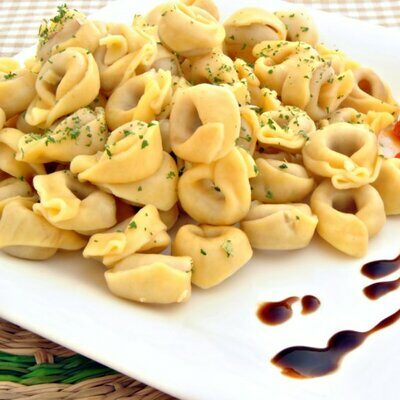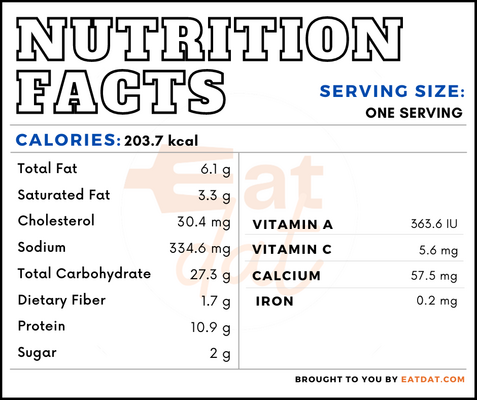
Tortellini
What is Tortellini?
Tortellini is a pasta dish originating from the Italian region of Emilia-Romagna. It has a hat-shaped appearance and, like most other pastas, is made of durum wheat. This is a stuffed pasta, with meat, cheese, eggs, and vegetables being the most popular fillings, served in a meat broth.
- It is a popular dish during Christmas.
- The name comes from the Italian word ‘tortello’, a short form of torta (pie), referring to the pie-like filling of the pasta.
Some popular stuffed pastas include:
- Ravioli
- Casoncelli
- Scàrpinocc de Pàrr
- Tortellini
- Tortelloni
- Cappelletti
- Cappellacci
- Agnolotti
- Anolini
- Marubini
- Agnolini
- Pansoti
- Zembi D’Arzillo
- Culurgiones
- Schlutzkrapfen
Origin of tortellini
This dish originated in the Italian cities of Bologna and Modena of the Emilia-Romagna province. Both cities lay claim to its invention. The earliest reference to this pasta is from the 12th century. According to one theory, it was created in Modena by an innkeeper, who peeked through a keyhole and saw Lucrezia Borgia’s navel. Another legend credits the pasta to be modeled after the navel of Venus.
In 1965, the Learned Order of the Tortellino was created in Bologna, in order to preserve its traditional form: meat stuffing in meat broth. In 1974, the exact recipe for tortellini was registered by this group along with the Italian Culinary Academy. Today, the Sagra del Tortellino is celebrated every September in the region. In the US, the National Tortellini Day is celebrated every year on February 13th.
Nutrition
Nutritional profile for tortellini en brodo (1 serving):

The main ingredient in pasta is wheat, which must be avoided by those with a gluten allergy. Pasta is made from durum flour, which has a lower glycemic index than regular flour. It can help control obesity, diabetes, and heart problems. Research shows that regular pasta eaters follow dietary patterns that give them higher amount of fiber and show an increased HEI (Healthy Eating Index).
Not to mention, chicken broth, which this pasta is often served in, has anti-inflammatory properties and is rich in micronutrients. Also, it helps control symptoms of respiratory tract infections.
Commercial production
Most pasta is produced commercially, though handmade pasta is also available. Pasta is made by mixing milled wheat, water, eggs, and other optional ingredients. The procedure involves adding these ingredients to a high capacity auger extruder, which is also equipped with dies to determine the shape. The pasta then has to be dried before packaging.
Pasta has a long shelf life and can be stored successfully anywhere in an airtight container. The USDA recommends pasta be consumed within two years. Fresh pasta must be kept in the refrigerator and consumed within 3 to 4 days.
Tortellini recipes
This dish can be made in a variety of ways, though the traditional and most popular recipe remains meat stuffing in a meat sauce. However, cheese and vegetables may also be used. Sweet and chocolate stuffed pastas are also popular. Here are a few recipes to try:
- Tortellini in Brodo
- Cheese Pasta in Garlic Butter Sauce
- Spinach Tomato Tortellini
- Tortellini Primavera
- Mushroom Stuffed Pasta
- Sweet Potato Stuffed Pasta with Hazelnut Sauce
- Tortellini Dolci al Forno
- Tortellini Dolci al Cioccolato
FDA regulations
The FDA classifies all pasta under macaroni products, which is defined as food prepared by drying units of dough made from semolina, durum flour, farina, flour, or a combination of these with water and other optional ingredients. These products are regulated strictly in the US for the seasonings, salt, gluten content, disodium phosphate, etc. The finished product must be at least 87% solid. The labeling of these products must include these specifications clearly. There is no specific standard of identity for tortellini.
References
Francine Segan, Tortellini in Brodo: The History of an Italian Christmas Classic, La Cucina Italiana: Authentic Italian Cooking since the 1920s, https://www.lacucinaitaliana.com/italian-food/italian-dishes/tortellini-in-brodo-the-history-of-an-italian-christmas-classic
Fulgoni, Victor L 3rd, and Regan Bailey. “Association of Pasta Consumption with Diet Quality and Nutrients of Public Health Concern in Adults: National Health and Nutrition Examination Survey 2009-2012.” Current developments in nutrition vol. 1,10 e001271. 19 Sep. 2017, doi:10.3945/cdn.117.001271. https://www.ncbi.nlm.nih.gov/pmc/articles/PMC5998777/
Rennard, B O et al. “Chicken soup inhibits neutrophil chemotaxis in vitro.” Chest vol. 118,4 (2000): 1150-7. doi:10.1378/chest.118.4.1150. https://pubmed.ncbi.nlm.nih.gov/11035691/
